ELEPHANT SEALS
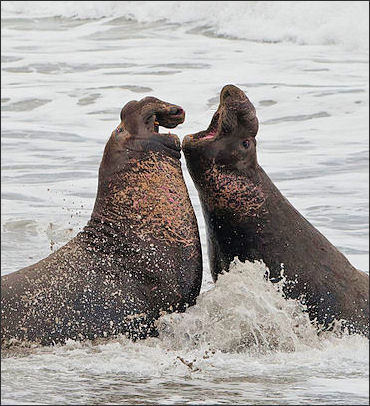
Alpha seals Elephant seals are amazing creatures. They can dive to depths of nearly a mile, stay submerged for hours at a time and go for months without sleeping. They are named after the large trunk-like proboscis that males possess. Groups of elephant seals are called pods. Females are called cows; males, bulls. [Source: Susan Casey, National Geographic, November 2008; Roger Gentry, National Geographic, April 1987; Kathleen McAuliffe, Smithsonian magazine]
Elephant seals are the world's biggest seals and the largest marine mammals other than whales. They are bigger than every land animal except for elephants. Susan Casey wrote in National Geographic, “When it comes to ocean predators, it is easy to underestimate the southern elephant seal... To judge by appearance, this is one misfit beast...The nose is a preposterous trunk that can grow one-and-a-half feet long, earning the elephant seal its name... Car-size and blimp-shaped on land the southern elephant seal...is usually found lolling around on the beach. But as with other sea creatures, the truth lies below the surface. Sure, its no supermodel, put underneath the blubbery disguise turns out to be a superhero, its life a series of magnificent feats.”
Elephant seals are larger than walruses, which are also quite large. A bull elephant seal typically weighs two to three tonnes or US tons and measure between 4.9 to 5.5 meters (16 and 18 feet). Cows are about half that length and maybe a quarter to a fifth of the weight. According to the Guinness Book of Records, the largest specimen ever measured was 6.8 meters (22½ feet) in length and weighed 3.6 tonnes (4 US tons). It was killed near South Georgia in 1913. Another one observed was 7 meters (20 feet) long and weighed around 3.85 tonnes (4.3 US tons) Their large body size helps them stay warm in the cold oceans. The males can be quite ugly with their large proboscises, but the females have surprisingly cute faces.
A beach covered by elephant seals can be a noisey place full of squealing, hissing, grunting, barking, belching and sighing. The loud, strangely metallic, pulsing noise like the pounding of a tin drum, is a “clap threat” made by bulls warning other bulls to keep their distance. Male elephant seals have attacked cars and caused major damage. Brent Stewart who has studied northern elephant seals for more than 30 years and tags a couple of thousand pups every year, told the Los Angeles Times, “They’re quiet and sneaky. When their eyes get all scrunched up, that’s when you want to run. British scientist Mike Fedak, who works with southern elephant seals, told National Geographic, “You really have to watch yourself. They can move with amazing agility for animals with no arms or legs.”
Related Articles: CATEGORY: SEALS: ioa.factsanddetails.com; Articles: SEALS: CHARACTERISTICS, SENSES AND WHISKERS ioa.factsanddetails.com; SEALS: HISTORY, BEHAVIOR, DIVING, FEEDING, REPRODUCTION ioa.factsanddetails.com; NORTHERN ELEPHANT SEALS: CHARACTERISTICS, BEHAVIOR, FEEDING, MATING ioa.factsanddetails.com ; SOUTHERN ELEPHANT SEALS: CHARACTERISTICS, BEHAVIOR, MATING ioa.factsanddetails.com
Websites and Resources: Animal Diversity Web (ADW) animaldiversity.org; National Oceanic and Atmospheric Administration (NOAA) noaa.gov; Fishbase fishbase.se; Encyclopedia of Life eol.org; Smithsonian Oceans Portal ocean.si.edu/ocean-life-ecosystems ; Monterey Bay Aquarium montereybayaquarium.org ; MarineBio marinebio.org/oceans/creatures
Northern and Southern Elephant Seals
There are two species of elephant seal— the northern elephant seal (Mirounga angustirostris) and the slightly larger southern elephant seal (Mirounga leonina). There are around 110,000 northern elephant seals and 325,000 southern elephant seals.

Proboscus of a male northern elephant seal Southern elephant seals are distinguished from northern elephant seals by their greater size and shorter proboscis. The southern males also appear taller when fighting, due to their tendency to bend their backs more strongly than the northern species. This species also exhibits the greatest sexual dimorphism of any mammal in terms of mass ratio, with males typically five to six times heavier than females. [Source: Wikipedia]
The southern elephant seal is the largest pinniped. It can reach 4.5meters in length and weigh four tons. They breed on island groups in the South Atlantic and southern Indian oceans and the Peninsula Valdez in Argentina. Male proboscises are smaller than those of their northern cousin. Southern elephant seals are more supple than northerners; they able to bend their bodies almost completely in half.
The northern elephant seal was hunted to the edge of extinction for its blubber but made a stunning comeback, from fewer than 100 animals — all on Guadalupe Island off Baja California — to over 200,000 today. Today northern elephant seals come ashore at beaches and islands from San Francisco to Baja California. After breeding they return to their offshore feeding grounds.
The number of southern elephant seals around certain Antarctic islands plummeted from 450,000 to 280,000 before stabilizing in the 1980s. Around 400,000 gather at South Georgia Island, about 1,500 kilometers east of the Falkland Island, for the breeding season, which runs from mid September to November. The populations of elephant seals on Peninsula Valdez has been increasing.
Elephant Seal’s Amazing Diving Ability
A northern elephant seal was recorded diving an astounding depth of 5,017 feet in May 1989 seal off of California. This is further down than any other aquatic mammal including the sperm whale has been recorded descending and deeper than most submarines can go. A dive of 5,017 feet is nearly a mile and is the equivalent of descending past four Empire State Buildings piled on top of one another. Elephant seals can stay submerged for two hours. For deep dives it takes around 60 minutes to descend and about the same amount of time to return to the surface. Other creatures live at 5,000 foot depths but die when taken to the surface.
Elephant seals keep breaking their own diving records. In 2002 one elephant seal was recorded traveling to a depth of 5,141 feet. In the late 1980s the deepest recorded dive was only "only" 2,900 feet. These diving feats are measured with dive recorders that often are crushed like squeezed aluminum cans by pressure of one ton per square inch. Census of Marine Life’s Tagging of Pacific Predators (TOPP) project , completed in 2011, recorded an elephant seal diving to 5,492 feet, deeper than any other tagged animal in a study of 23 species of ocean predators.
Humans that dive more than 150 feet run the risk of falling unconscious from nitrogen narcosis or dying of decompression sickness (the painful frothing of the nitrogen in the blood) associated with the bends when they return to the surface.
How and Why Elephant Seals Dive So Deep
Biologist believe that elephant seals developed their extraordinary diving ability to escape potential predators like great white sharks and get at food sources that few other marine creatures can reach. An elephant seal’s large brown eyes can gather the dimmest rays of light, particularly the short blue wavelengths found in the depths.
The average elephant seal dive is around 40 minutes but some individuals have been observed staying submerged for two hours. Even after a particularly long dive they need only a few minutes on the surface to recover. What is even more amazing is that elephant seals dive like this again and again, 24 hours day, for months at a time, apparently without sleeping or somehow sleeping while they dive. No other mammal ever studied can go without sleeps for such long periods. Wendell seals, in contrast, rest 11 to 13 hours every day. Whales take regular naps between 30 minutes and several hours between dives.
According to Animal Diversity Web: The extended period of time in which these animals stay under water is not brought about by their ability to hold their breath. Air is dispelled from the lungs before these seals dive, and throughout the 20 to 70 minutes the animal is under water, the oxygen they require is obtained from their blood and tissues. Northern elephant seals possess blood that is rich with hemoglobin and tissues rich in myoglobin, thus increasing their oxygen storing abilities. [Source: Karen Warburton, Animal Diversity Web (ADW) /=]
During long dives, elephant seals drop their body temperature by 5 or 6 degrees, shut off circulation to their kidneys, stomachs and other organs to conserve oxygen and slow their heart beat to as slow as two beats per minute (slow enough to regarded as cardiac arrest in humans).The lungs of Wendell seals collapse at a depth of around 100 feet and stay collapsed when the seal dives further and reinflate when the animal ascends. Scientists believe the same thing happens to elephant seals, who draw oxygen from their blood and muscles, and possibly their spleens, during long dives not from their lungs. They are able to get enough oxygen this way because about 20 percent of their body weight is blood compared to seven percent in humans.
Elephant Seals Sleep at 377 Meters Deep in the Ocean to Avoid Predators
Elephant seals drift downwards in a "sleep spiral" when deep diving in the ocean but are programmed not to drown. One reason they do it is to avoid predators, scientists believe. Business Insider reported: The seals fall into sleep during deep dives of up to 377 meters (1,235 feet) and spiral downwards for about 10 minutes at a time during half-hour dives, and they sometimes even catch some sleep on the sea floor, according to new findings published in Science. [Source: Isobel van Hagen, Business Insider, April 22, 2023]
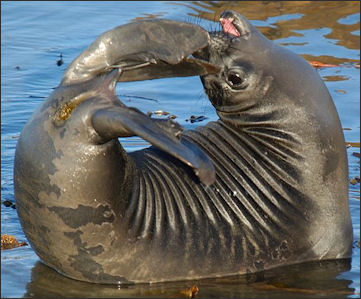
Elephant seal pup The study marks the first time scientists have studied the brain waves and recorded the sleeping habits of a free-ranging, wild marine mammal, according to the University of California, Santa Cruz. The study examined the crucial nature of sleep for mammals, and pointed out that marine mammals "encounter especially challenging conditions for sleep when they are at sea." "For years, one of the central questions about elephant seals has been when do they sleep," Daniel Costa, director of the UCSC Institute of Marine Sciences, said.
The lab used tags to track the movements of elephant seals in the Año Nuevo Reserve when the animals head out to the Pacific Ocean for months at a time. "The dive records show that they are constantly diving, so we thought they must be sleeping during what we call drift dives, when they stop swimming and slowly sink, but we really didn't know," Costa continued. Professor Terrie Williams, from UC Santa Cruz, told BBC News that it was "remarkable" that any mammal would fall asleep while drifting hundreds of feet below the water surface. "This is not light sleep but real paralytic, deep sleep that would have humans snoring. Remarkably, the seal's brain reliably wakes them out of it before running out of oxygen. "Imagine waking up on the bottom of a pool - it sends a shiver down the spine," said Williams.
African elephants currently hold the title of mammal that sleeps the least, at just two hours a day, but these new finding show that elephant seals "rival the record," according to UCSC. Killer whales and sharks attack elephant seals when they are at the surface of the ocean, which is why they spend so little time near the top and only take a short time breathing at the surface between dives, per UCSC. "They're able to hold their breath for a long time, so they can go into a deep slumber on these dives deep below the surface where it's safe," said Jessica Kendall-Bar, who led the study.
The scientists fitted neoprene headcaps with electroencephalogram (EEG) sensors to record the 13 young female seals' brain activity. "We used the same sensors you'd use for a human sleep study at a sleep clinic and a removable, flexible adhesive to attach the headcap so that water couldn't get in and disrupt the signals," Kendall-Bar, a postdoctoral fellow at UC San Diego's Scripps Institution of Oceanography, said. The recordings showed the diving seals going into a sleep stage known as "slow-wave sleep" before transitioning into REM sleep, which leads to a kind of "sleep spiral" or sleep paralysis, experts found. Elephant seals do get a lot of sleep when they are on land — about 10 hours — scientists said, which makes their sleeping pattern "unusual."
Elephant Seal Food, Hunting and Migration
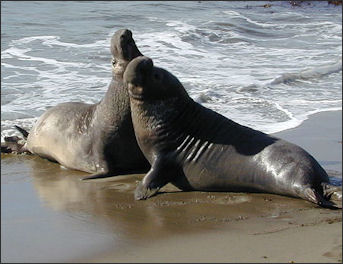 Elephant seals feed on squid and fish. They eat about 18 kilograms (40 pounds) of food a day. Female northern elephant seals migrate to a spot north of Hawaii and feed on scary-looking bioluminescent fish that live between 1,500 and 2,400 feet. Bulls migrate father north near the Aleutians, where the dive to top of sea mounts and feed on a variety of creatures including skates, ratfish, rays and sharks at depths of around 1,500 feet.
Elephant seals feed on squid and fish. They eat about 18 kilograms (40 pounds) of food a day. Female northern elephant seals migrate to a spot north of Hawaii and feed on scary-looking bioluminescent fish that live between 1,500 and 2,400 feet. Bulls migrate father north near the Aleutians, where the dive to top of sea mounts and feed on a variety of creatures including skates, ratfish, rays and sharks at depths of around 1,500 feet.
Except for the two or three month summer mating season, elephant seals spend their entire time at sea usually hundreds of miles from the nearest shore. How elephant seals can hunt these creatures in complete darkness at crushing pressure when their heart is beating only a few beats a seconds and many of their organs have been shout down has not been adequately explained.
It was long thought that northern elephant seals hunted near their breeding ground on islands off of California. The tagging of these animals however show that migrate far to the North Pacific, mostly alone, and spend nine mother of the year hunting While the out at sea they spend about three minutes on the surface and then dive for 20 minutes’sometimes to a depth of 1700 meters — before returning to the surface and then repeating the pattern over and over.
During their nine months at sea elephant seals might travel 20,000 kilometers and spend 80 percent of the time underwater. They appear to be skilled at riding currents and finding places where water is rich in nutrients, feeding on the food chain. Census of Marine Life’s Tagging of Pacific Predators (TOPP) project noted, the same female elephant seal tagged in 1995 off the island of Ano Nuevo north of Santa Cruz “took the same exact path 11 years later” when researchers tagged her again.
Sharks and killer whales feed on seals. Great white sharks sometimes even eat elephant seals. A large one found off of California was dissected and large chunks of elephant seal were discovered inside, including a completely severed head. Elephant seals were hunted, like whales, by humans for their oil-making blubber. They were easy targets while on land and their numbers were greatly reduced. Since a hunting ban was initiated in the 1960s they have made a remarkable comeback.
Elephant Seals Feed 1,000 to 2,000 Times Daily
Elephant seals are big, heavy animals and takes a lot of work to stay that way. Will Dunham of Reuters wrote: Scientists have conducted the most thorough study to date of the unique feeding behavior of northern elephant seals, focusing on the females of the species during arduous two-month post-breeding migrations in the northeastern Pacific Ocean. The seals were found to spend upwards of 20 hours every day — and sometimes a full 24 hours — in continuous deep-diving to feed on multitudes of small fish, rather than the larger prey favored by other deep-diving marine mammals, to gain the body fat essential for successful reproduction and insulation in the frigid depths. They fed 1,000 to 2,000 times daily. "It is not easy to get fat," said marine biologist Taiki Adachi of the University of St Andrews in Scotland, who led the study published in May 2021 in the journal Science Advances. [Source: Will Dunham, Reuters, May 14, 2021]
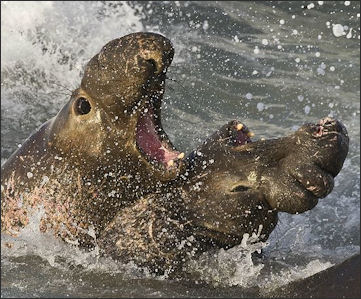
Elephant seals fighting “The researchers tracked 48 female elephant seals from Año Nuevo State Park in California, site of an important breeding colony, as they covered vast ocean distances. Their round-trip migration was up to around 3,700 miles (6,000 kilometers). They based their findings on data obtained from 2011 and 2018 using three small removable devices: one attached under the jaw that counted the number of times they fed and measured their depth; a satellite tracker attached atop the head that provided location information; and a "smart" video camera with an infra-red LED light flash, motion tracker and another depth sensor, also atop the head.
“Some large marine mammals rely upon deep dives to forage for meals, with more food needed based on the animal's size. Sperm whales, perhaps the heavyweight champions of the deep dive, hunt for large prey like giant squid. The female elephant seals, also large but not on the scale of a sperm whale, have devised a different solution — eating huge amounts of small fish. But it is laborious to catch enough small fish to meet the energy needs of such a large animal. "They continuously dive, for long periods of time — 20 minutes on average and about 100 minutes at maximum — and deep — 500 meters (1,640 feet) on average and about 1,500 meters (4,920 feet) at maximum — with only a few minutes breathing at the surface," Adachi said. "During the two-month migration, they never come back to the land. The sleeping hours in at-sea animals is not fully understood. But, based on our record of extreme foraging, their available time for sleeping should be less than 20 percent of the day."
Elephant Seal Mating Behavior
Only about a third of males win the chance to breed. Dominant males stake out a stretch of beach and establish huge harems. They may inseminate hundreds of cows during the summer mating season. The majority of males end up as lonely bachelor seals, wandering the seas by themselves and never having sex. Scientists call the dominant males beachmasters. Their harems can range in size from 20 females to more than 300, with the largest have over 1,000 members.
Large males fiercely defend their harems against other males. During the mating season bulls make loud bellowing noises, puff up their noses and ram one another. Occasionally they bite each other, sometimes inflicting terrible wounds. The fights can go on for hours — with the males wacking each other with their chests and pendulous snouts, sending chunks of flesh flying in the air and piecing the wind with the sound of deep thwacks. The elephant seals often have blood all over their faces. Occasionally eyes land on the ground. Most fights end with the weak bull backing down.
Female elephant seals often try to escape the bull males but the males are faster and often catch the females. The mating process itself often looks quite violent. The bulls are often very rough, seizing the females in their jaws by the scruff of the females’ neck and almost crushing the females with their weight.
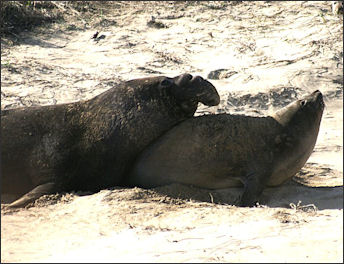
Mating elephant seals A few secondary males gets some action. While the main bulls are engaged in trying to capture and mate with females, junior males see opportunities to stealthily approach other receptive females and mate with them. Females howl and protest when the dominant male tries to mate with the, but howl even louder when lesser males try to mate with them.
Both males and females eat little if anything during the breeding season. Females that escape into the water are approached by males hovering around the waves. For males, defending the beach often means not going back to the sea to eat. A male typically loses 30 percent of its weight during the three-month breeding season and may lose more than half its blubber.
Elephant Seal Females and Young
Females arrive in the breeding area about a month after the males. First they give birth to their pups, then suckle them and about three weeks after they give birth, mate again. They often join a harem not to have sex with the dominant male but to get his help warding off unwanted advances by other males.
Young pups are born after a ten month incubation period. For their first month or of life they feed entirely on their mother’s fat-enriched milk and gain about five kilograms a day.
Sea elephant pups have been observed standing on their sleeping mothers, at which time she uses her flipper to gentle brush them off. As the females prepare to leave the beach she mates, weans her pup abruptly and leaves, returning to same shores ten months later to give birth to a new pup.
Young pups start going to the sea to fend for themselves when they are two months old. The pups head out into the sea on their own with no training or guidance.
Studying Elephant Seals

Elephant seal colony Marine scientists such as Daniel P. Costa studying elephant seal migrations work with a lightly anesthetized male northern elephant seal. Cheryl Lyn Dybas wrote in Natural History magazine: After using fast-acting epoxy to glue a telemetry tag to the hair on the animal’s head, they measure blubber thickness with an ultrasound device and collect blood samples. [Source: Cheryl Lyn Dybas, Natural History magazine, September-October 2012]
In an effort to unveil some of the mysteries of elephant seal behavior, Burney Le Boeuf, a marine biologist at the University of California at Santa Clara, attached a video camera to the back of an elephant seal with epoxy glue. The camera was retrieved when the seal came ashore and molted its skin. The images, some from great depths, where mostly of inky black water with a few blurs. To attract males to a weigh station on the beach, biologists use a decoy of female complete with a waging tail and a speaker blasting out the sounds made by a cow having sex.
By studying elephant seals, biologist are hoping to understand how children can survive long periods submerged in cold water, how doctors might control irregular heartbeats and how children might die from sudden infant death syndrome.
Southern elephant seals tagged with satellite tracking devises are not only providing important data about themselves they are also providing important data about the currents, temperatures and salinity in the depths of the Southern Ocean, which plays a critical role in global ocean current circulation and for which there is little data and collecting it without elephant seals would be very difficult.
Image Sources: Wikimedia Commons, NOAA, Diving ability from New Zealand government
Text Sources: Animal Diversity Web (ADW) animaldiversity.org; National Oceanic and Atmospheric Administration (NOAA) noaa.gov; Wikipedia, National Geographic, Live Science, BBC, Smithsonian, New York Times, Washington Post, Los Angeles Times, The New Yorker, Reuters, Associated Press, Lonely Planet Guides and various books and other publications.
Last Updated June 2023

